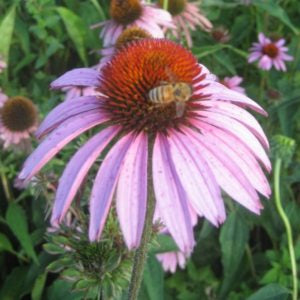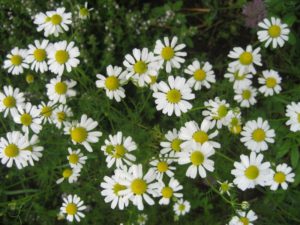You may have heard people say that herbal tea isn't actually tea, since it doesn't contain leaves from the tea plant. Some might use the word tisane to describe a brew of herbs in water. However you choose to call it, one thing is certain: it's good all year round. Right now in particular is the perfect herbal tea season: you might crave a hot mug of it as the mornings grow cooler, but by the afternoon, you're ready for an iced glass of sun tea. And your garden is probably full of ingredients to make it! Today, we'll dip our toes (not literally) into tea-making: the process, the plants, and the many options you have to make a healing and soothing herbal drink.
 HERBAL TEA: THE BASICS
HERBAL TEA: THE BASICS
Fresh vs. dry: Tea can be made with either fresh herbs or dried. It's satisfying to use herbs fresh out of your garden in the summer. Fresh herbs have a stronger scent but a less concentrated flavor, meaning you'll need to use more of them in your teas--approximately two or three times as much. Cut or tear your fresh leaves prior to use to help release the flavor and properties. Per cup of water, the general rule of thumb is to use one to two teaspoon of dried herb or two tablespoons of fresh herb.
Drying herbs: To make your herbal medicine last the winter, you can dry what you've grown. Thick, waxy-leaved herbs can be dried by hanging them upside-down in a cool, dry place for one to three weeks. Soft-leaved herbs like parsley, basil, and mint need a faster drying process so they don't mold. Place them in in bright light (but not direct sun) on top of a towel until they are completely dry. You can also dry leaves at a very low temperature in the oven, turning them frequently until they are crisp. If you're looking to make tea with the seeds of fennel, coriander, or the like, place the herbs in a brown paper bag. The seeds will fall out into the bag for easy use. Your dried herbs can be stored in airtight containers in a dark, cool place for several months.
Brewing: There are two options for infusing herbs into water. The most common is to pour boiling water over them, let it steep for 15 minutes, and then strain the herbs out. While we've still got hot summer days, however, you can also steep the tea in a pitcher in the sun for three to five hours, depending on how concentrated you want the flavor to be. Strain and chill before serving. For some of our favorite sun tea recipes, check out this blog post.
CHOOSE YOUR BREWS
The definition of herb is flexible. We've got a great collection of herbs in our catalog, a lot of which make wonderful teas. Here are just a few fragrant leaves and flowers you might try steeping.
 Sacred Basil: Considered a sacred plant in the Hindu religion, Sacred Basil, or Tulsi, has been cultivated for at least 3000 years. The scent, as well as preparations of the plant, have been used to heal for centuries. Today's plant scientists have determined that it has adaptogenic, stress-relieving, and immune-boosting properties, among others. Try adding a little honey to your Tulsi tea.
Sacred Basil: Considered a sacred plant in the Hindu religion, Sacred Basil, or Tulsi, has been cultivated for at least 3000 years. The scent, as well as preparations of the plant, have been used to heal for centuries. Today's plant scientists have determined that it has adaptogenic, stress-relieving, and immune-boosting properties, among others. Try adding a little honey to your Tulsi tea.
 Echinacea: Coneflower's stately purple flowers are a panacea for pollinators, and they're beneficial to us too. Echinacea has been used for hundreds of years as an antimicrobial treatment and to sooth sore throats, and today it's widely known as an immune booster. It's medicinal properties can be found in its petals, leaves, and roots. Petals and leaves can be used as above (though be sure to harvest flowers just as they are opening), but roots differ in their harvest and usage. Harvest in late fall, after the flowers have gone to seed and a couple frosts have passed. Cut just a portion of the root so that the plant will come back in the spring. Wash it and cut it into small pieces, and lay them out for several days or until dry. To use, make a decoction by using two teaspoons of dried root per cup of water and simmer for twenty to thirty minutes and then strain.
Echinacea: Coneflower's stately purple flowers are a panacea for pollinators, and they're beneficial to us too. Echinacea has been used for hundreds of years as an antimicrobial treatment and to sooth sore throats, and today it's widely known as an immune booster. It's medicinal properties can be found in its petals, leaves, and roots. Petals and leaves can be used as above (though be sure to harvest flowers just as they are opening), but roots differ in their harvest and usage. Harvest in late fall, after the flowers have gone to seed and a couple frosts have passed. Cut just a portion of the root so that the plant will come back in the spring. Wash it and cut it into small pieces, and lay them out for several days or until dry. To use, make a decoction by using two teaspoons of dried root per cup of water and simmer for twenty to thirty minutes and then strain.
 Chamomile: Ancient Greeks used this soothing flower to treat fever, improve mood, and induce relaxation, in addition to using them in beer-making. Flowers, leaves, and stems can be used for tea. Steep them gently to maintain the delicate flavor. To dry flowers, you'll need plenty of ventilation and a flow of air from a fan or dehydrator.
Chamomile: Ancient Greeks used this soothing flower to treat fever, improve mood, and induce relaxation, in addition to using them in beer-making. Flowers, leaves, and stems can be used for tea. Steep them gently to maintain the delicate flavor. To dry flowers, you'll need plenty of ventilation and a flow of air from a fan or dehydrator.
 Calendula: It can be hard to pluck the pretty golden petals from this plant rather than simply admire it, but its skin-healing benefits are well worth it. Pick them in the morning just after dew has dried, choosing the freshest, newest flowers. Dry them in a dehydrator or another well-ventilated place before steeping or storing, or eat the petals raw. Calendula is also used in tinctures, infusions, and salves.
Calendula: It can be hard to pluck the pretty golden petals from this plant rather than simply admire it, but its skin-healing benefits are well worth it. Pick them in the morning just after dew has dried, choosing the freshest, newest flowers. Dry them in a dehydrator or another well-ventilated place before steeping or storing, or eat the petals raw. Calendula is also used in tinctures, infusions, and salves.
That's just the start! Experiment with all aspects of your tea: the ratios, proportions, steeping times, and combinations. Try adding dried fruit, spices, or honey. Try it hot or cold. Simply sip and savor the beautiful healing plants that came from your garden.





